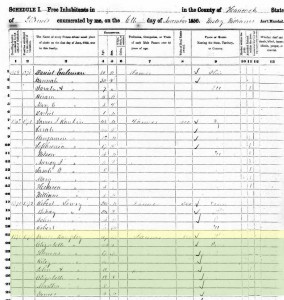I have James Rampley in the 1850 Hancock County, Illinois, federal United States Census and yet I really don’t know where he lived. At least I don’t know very precisely based upon what the census tells me.
The entire 1850 census of Hancock County, Illinois, does not include any township, cit y, or village designations. All 14, 738 residents of the county are enumerated in one large group.
y, or village designations. All 14, 738 residents of the county are enumerated in one large group.
Back when the census was unindexed (yes, there was such a time), searching manually was difficult.
When viewing the pages, one can get an idea of whether the area is rural or not, depending upon how many farmers are listed on each page. When residents are shopkeepers, merchants, lawyers, day laborers, etc. the location is more likely to be one of the several towns contained within the county.
There is no post office listed in this enumeration either.
The neighbors are the biggest clue. The entry in this illustration is for Maryland native, James Rampley. (dwelling 1371, family 1373–the next page is stamped 365 in the upper right hand corner and the digital image was obtained in Ancestry.com‘s “1850 United States Federal Census” collection on 15 April 2015). James was known to have lived in Walker Township the entire time he lived in Hancock County, so in this case, the fact that the residence is not listed for him is not a problem.
However….
If I had not known James’ residence, I could have gotten a general idea by looking at him and his neighbors. Four heads of household on the same census page own real property in 1850. Some of them may have been living in the same location in 1860 and that census provides township locations. Land records would also have indicated where men with those names owned property during the 1850 time frame.
I could have searched for James’ neighbors in 1840 and 1860 to see where they were in those census years and whether those men were still living as relatively near neighbors. Even though James was not in Hancock County in 1840, his 1850 neighbors may still have been.
The easiest way to see where James probably lived would have been to look at land records–since he owned land. But if the person of interest had been one of the non-landowners in the area, tracking down the landowners may have helped me to approximate where my actual person of interest was living in 1850.

2 Responses
Land records are some of the most overlooked sources in genealogical research. When suggesting to patrons in the state archives that they consult deed records, I get this comment. “Oh, I know where they lived!” What they don’t know is that they may be missing out on some really valuable information!
Land records can often answer questions not mentioned in other records–especially when the landowner dies with out a will. I might suggest that “if they know where they live,” then that makes it easier to find land records 😉 (well at least usually makes it easier…)